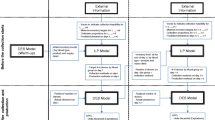Abstract
This case study is concerned with analysing policies for managing the blood inventory system in a typical UK hospital supplied by a regional blood centre. The objective of the project is to improve procedures and outcomes by modelling the entire supply chain for that hospital, from donor to recipient. The supply chain of blood products is broken down into material flows and information flows. Discrete-event simulation is used to determine ordering policies leading to reductions in shortages and wastage, increased service levels, improved safety procedures and reduced costs, by employing better system coordination. In this paper we describe the model and present results for a representative medium-sized hospital. The model can be used by both the National Blood Service and by hospital managers as a decision support tool to investigate different procedures and policies.



Similar content being viewed by others
References
Blake J (2003). Optimizing the platelet supply chain in Nova Scotia. In: Dlouhý M (ed). Proceedings of the 29th Meeting of the European Working Group on Operational Research Applied to Health Services. ORAHS, Prague, Czech Republic, pp 47–66.
Brandeau ML, Sainfort F and Pierskalla WP (2004). Operations research and health care: a handbook of methods and applications. Series: International Series in Operations Research & Management Science, Vol. 70, chapter 5, pp 103–146.
Brodheim E and Prastacos G (1980). Demand usage and issuing of a blood at Hospital Blood Banks. Technical Report, Operations Research Laboratory, The New York Blood Centre.
BSMS Blood Stocks Management Scheme (2001). Ad hoc exercises summer 2001. Preliminary Report, BSMS, PO Box 33910, London, NW9 5YH.
BSMS Blood Stocks Management Scheme (2003). Inventory Practice Survey 2003. BSMS, PO Box 33910, London, NW9 5YH.
Chazan H and Gal S (1977). A Markovian model for a perishable product inventory. Mngt Sci 23: 512–521.
Cohen MA and Pierskalla WP (1979a). Target inventory levels for a hospital blood bank or a decentralised regional blood banking system. Transfusion 19(4): 444–454.
Cohen MA and Pierskalla WP (1979b). Simulation of blood bank systems. Simuletter 10(4): 1–8.
Currie CJ, Patel TC, McEwan P and Dixon S (2004). Evaluation of the future supply and demand for blood products in the United Kingdom National Health Service. Transfusion Medicine 14: 19–24.
Elston R and Picrel JC (1963). A statistical approach to ordering and usage policies for a Hospital Blood Bank. Transfusion 3: 41–47.
Fries B (1975). Optimal ordering policy for a perishable commodity with fixed lifetime. Opns Res 23: 46–61.
Goh C, Greenberg BS and Matsuo H (1993). Perishable inventory systems with batch demand and arrivals. Opns Res Lett 13(1): 1–8.
Jagannathan R and Sen T (1991). Storing crossmatched blood: a perishable inventory model with prior allocation. Mngt Sci 37(3): 251–266.
Jennings JB (1973). Blood inventory control. Mngt Sci (Application Series) 19(6): 637–645.
Jones RL (2003). The blood supply chain, from donor to patient: a call for greater understanding leading to more effective strategies for managing the blood supply. Transfusion 43(2): 132–141.
Kopach R, Frances DM and Sadat S (2003). Models for predicting a critical blood product. In: Dlouhý M (ed). Proceedings of the 29th Meeting of the European Working Group on Operational Research Applied to Health Services. ORAHS, Prague, Czech Republic, pp 77–90.
Nahmias S (1976). Myopic approximation for the perishable inventory problem. Mngt Sci 22: 1002–1008.
Nahmias S (1982). Perishable inventory theory—a review. Opl Res 30: 680–780.
Nahmias S and Pierskalla WA (1973). Optimal ordering policies for a product that perishes in two periods subject to stochastic demand. Naval Res Logistics Q 20: 207–229.
Pierskalla W, Deuermeyer B and Sassetti R (1977). Methods for reducing outdating without altering physician ordering patterns. Technical Report. Department of Industrial Engineering and Management Sciences, Northwestern University, Evanston, Illinois.
Prastacos GP (1984). Blood inventory management; an overview of theory and practice. Mngt Sci 30(7): 777–800.
Rabinowitz M and Valinsky D (1970). Hospital Blood Banking—an evaluation of inventory control policies. Mt. Sinai School of Medicine, City University of New York.
Sirelson V and Brodheim E (1991). A computer planning model for blood platelet production and distribution. Comput Meth Programs Biomed 35: 279–291.
Spens KM and Bask AH (2002). Developing a framework for supply chain management. Int J Logistics Mngt 13(1): 73–88.
Wells AW et al (2002). Where does blood go? Prospective observational study of red cell transfusion in north England. BMJ 325: 803.
Acknowledgements
We thank Crispin Wickenden and Mike Northcott from the NBS for their time, advice and support, without which the project would not have been possible. We also thank several employees of the Southampton NBS Centre for their time and effort during the data collection, particularly Andrew Oliver for the provision of the complete database and Tracey Lofting from Southampton General Hospital for her enlightening comments. We express our gratitude to the members of the Blood Stocks Management Scheme for helping with the validation and potential use of the model.
Author information
Authors and Affiliations
Corresponding author
Rights and permissions
About this article
Cite this article
Katsaliaki, K., Brailsford, S. Using simulation to improve the blood supply chain. J Oper Res Soc 58, 219–227 (2007). https://doi.org/10.1057/palgrave.jors.2602195
Received:
Accepted:
Published:
Issue Date:
DOI: https://doi.org/10.1057/palgrave.jors.2602195




